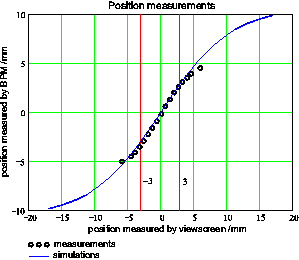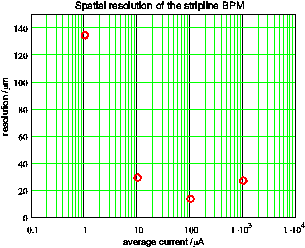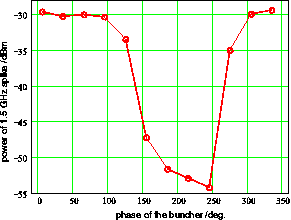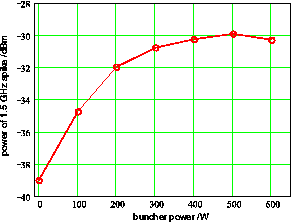|
The ELBE accelerator needs a system to monitor the electron beam position in full power mode. The system will be used for optimization of the electron beam transport in the accelerator and for control of the electron beam position at the targets. The system must be nondestructive and should not affect the electron beam quality. Required resolution is about 100 mm for ±5 mm from center. For this reason a system of stripline beam position monitors (BPM) is under design. The stripline BPM is a nondestructive device with negligible influence on the beam behavior. It is known that with stripline BPMs one can easily achieve a resolution considerably smaller than 100 mm.
To verify the basic principles of the stripline BPM and to get information about the BPMs signal behavior we did a set of measurements on the ELBE injector with a CEBAF FEL stripline BPM. We have to note that the CEBAF BPM was build for an accelerator with the fundamental frequency 1.5 GHz (as compared to 1.3 GHz at ELBE) and another beam pipe diameter. So this BPM has properties slightly different from BPM designed for ELBE. But nevertheless the general behavior of the BPM is the same and therefore the measurements were very useful for our understanding. The measurements were also necessary for the design of the BPM electronics. By means of a spectrum analyzer we measured the amplitude of the BPM signal at 1.5 GHz as a function of the beam current. The measurements gave the dynamic range of the signal which we have to take in to account in the electronic design. We also measured the amplitude of the signals from two opposite strips as a function of the beam position. The position of the beam was measured by a cromox viewscreen with a resolution much better than the BPM resolution. From this measurements we estimated the sensitivity and the achievable resolution of the BPMs. We also did simulations of the BPM signal behavior. The simulations were done by a simple Mathcad code. The code gives the capability to calculate the spectrum of the BPM signal as a function of bunch charge, bunch length and beam position. Here we present the results of the simulations together with results of the measurements as described above. The measured sensitivity of the BPM is 243 mV/mm versus calculated 232 mV/mm such that there is a difference of 4.5 %. The deviation between measurements and simulation for the beam displacements of more than 3 ¸ 4 mm is due to the fact that during the measurements the BPM was installed downstream of the dipole with relatively small gap (the electron beam was cut by the vacuum chamber in the dipole). One of the BPMs will be installed downstream of the first cryomodule. The BPM will serve for measurements of the electron beam position at the entrance of the cryomodule and for setting the correct phase and power of both bunchers of the injector. The electron bunch from the injector must enter into the module in the accelerating phase of the RF field and must have minimal length. Since the power spectrum of the beam depends on the bunch length measurements in the frequency domain can give information about the bunch length and one thus gains important information to set the bunchers. To check this possibility we did two sets of measurements. By means of a spectrum analyzer we measured the power of the 1.5 GHz peak in the BPM signal spectrum with different settings of the first subharmonic buncher. The maximum of the signal corresponds to the minimum of the bunch length. Thus the optimum settings of the subharmonic buncher are turned out to be 500 W power and 5o phase.
Fig. 2 Measured power at 1.5 GHz with the following conditions: (left) dependence of the signal on the buncher phase with the power of the buncher set at 500 W; (right) dependence of the signal on the buncher power with the buncher phase constant at 5o. 1 Thomas Jefferson National Accelerator Facility, Newport News, Virginia 23606, USA
|



